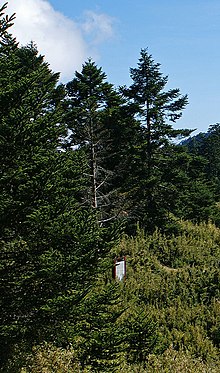Abies kawakamii
| Abies kawakamii | |
|---|---|

| |
| Scientific classification | |
| Kingdom: | Plantae |
| Clade: | Tracheophytes |
| (unranked): | Gymnosperms |
| Division: | Pinophyta |
| Class: | Pinopsida |
| Order: | Pinales |
| Family: | Pinaceae |
| Genus: | Abies |
| Species: | A. kawakamii
|
| Binomial name | |
| Abies kawakamii (Hayata) T.Ito
| |
Abies kawakamii is a species of conifer in the family Pinaceae. It is found only in Taiwan. First described in 1908 by Bunzō Hayata as a variety of Abies mariesii, a high-mountain fir native to Japan; the next year it was elevated to species rank by . Abies kawakamii is exclusively native to the island of Taiwan, and is one of the southernmost true firs (together with , native to Vietnam, and A. guatemalensis, from Mexico and Guatemala). It is a high-mountain species occurring in northern and central Taiwan at elevations between 2400 and 3800 m in association with other temperate plants, dominantly conifers, including Juniperus formosana var. formosana, Tsuga formosana, and Juniperus morrisonicola.[2]
Taiwan fir is a small to medium-sized tree sometimes reaching a height of 35 m and trunk diameter of 1 m. Initially, the bark is scurfy or scaly, lenticellate, later detaching in elongated plates. The branchlets are yellowish-brown when mature, furrowed, hairy. The needles are 1–2.8 cm long, pruinose, with stoma-lines above and 2 stomatal bands below. It has rather small cones 5–7.5 cm long, cylindrical or conical-cylindrical, dark blue, with included bracts.[2]
References[]
- ^ Thomas, P.; Liao, W.; Yang, Y. (2013). "Abies kawakamii". IUCN Red List of Threatened Species. 2013: e.T31362A2805686. doi:10.2305/IUCN.UK.2013-1.RLTS.T31362A2805686.en. Retrieved 16 November 2021.
- ^ a b Zsolt Debreczy; Istvan Racz (2012). Kathy Musial (ed.). Conifers Around the World (1st ed.). DendroPress. p. 1089. ISBN 978-9632190617. Retrieved 19 July 2012.
- IUCN Red List near threatened species
- Abies
- Endemic flora of Taiwan
- Trees of Taiwan
- Near threatened flora of Asia
- Plants described in 1908
- Conifer stubs
